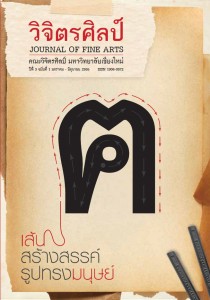ศิลปะจีนร่วมสมัยหนึ่งศตวรรษจากอดีตสู่ปัจจุบัน
Main Article Content
Abstract
จนกระทั่งในที่สุด เมื่อการปฏิวัติวัฒนธรรมจบสิ้นลง พร้อมๆ กับการประกาศนำจีนไปสู่ความก้าวหน้าด้วยนโยบาย “4 ทันสมัย” มีการนำระบบตลาดเสรีของทุนนิยมมาประยุกต์ใช้กับการพัฒนาเศรษฐกิจภายใต้ระบอบการปกครองแบบคอมมิวนิสต์จัดตั้งเขตเศรษฐกิจพิเศษและการสร้างประเทศจีนใหม่ด้วยรูปแบบ “หนึ่งประเทศสองระบบ” จีนดำเนินนโยบายเปิดประตูสู่โลกภายนอกอย่างเต็มที่ ทำให้กระแสอิทธิพลศิลปะตะวันตกจากโลกเสรีหลั่งไหลเข้าสู่การเปลี่ยนแปลงของวงการศิลปะจีนสมัยใหม่เพิ่มขึ้นทวีคูณ ได้มีการรวมตัวกันของศิลปินรุ่นใหม่ผู้มีอุดมการณ์ร่วมกันในแนวทางทำงานศิลปะแบบเดียวกันเป็นกลุ่มศิลปะการเกิดขึ้นของกลุ่มศิลปะกลายเป็นปรากฏการณ์ทางสังคมที่ขยายวงจากการเสียดสีสังคมมาเป็นการโจมตีการทุจริตคอรัปชั่นและชนชั้นผู้มีอำนาจในพรรคคอมมิวนิสต์จีน ติดตามมาด้วยความเคลื่อนไหวเพื่อเรียกร้องประชาธิปไตยครั้งใหญ่ในกรุงปักกิ่ง แต่ก็ต้องจบลงด้วยการสลายการชุมนุมจากการปราบปรามของรัฐบาลเมื่อเดือนมิถุนายน ค.ศ. 1989 เรียกกันว่า “เหตุการณ์ที่จัตุรัสเทียนอันเหมิน” แต่เหตุการณ์ดังกล่าวนี้ก็ได้สร้างเมล็ดพันธุ์แห่งปัญญาและความกล้าของศิลปินคนรุ่นใหม่ให้หลุดพ้นกรอบของประเพณีนิยมไปสู่การเรียนรู้ศิลปะสมัยใหม่ในระดับสากล ส่วนหนึ่งมาจาก “กลุ่มศิลปินหัวก้าวหน้า” ที่ลี้ภัยในต่างประเทศและอีกส่วนหนึ่งได้รวมตัวกันทำงานศิลปะตามอุดมการณ์ของตนเองที่หมู่บ้านตะวันออกปักกิ่ง และตามมาด้วยการรวมตัวศิลปินจนวนมากมาทำงานและจัดนิทรรศการในพื้นที่เดียวกัน เรียกกันว่า “ชุมชนศิลปะ 798”
และด้วยสิ่งต่างๆ เหล่านี้เองทำให้ศิลปะจีนร่วมสมัยมีผลงานที่แพร่หลายออกสู่ต่างประเทศด้วยความหลากหลายของผลงานและเอกลักษณ์อันแปลกใหม่ ผลงานของศิลปินจีนร่วมสมัยหลายภาพมีมูลค่ามหาศาลและได้รับการยอมรับอย่างกว้างขวาง สิ่งที่ไม่สามารถปฏิเสธได้นั้นก็คือ รากฐานของความคิดและประสบการณ์จากในอดีตได้บ่มเพาะให้ศิลปินมีความกล้า มีความท้าทาย และมีความคิดสร้างสรรค์ในแบบอย่างเอกลักษณ์เฉพาะตัว จนทำให้ประสบความสำเร็จในระดับนานาชาติในปัจจุบัน
Chinese art contemporary : A Century from Past to Present.
The change of Chinese art from modern Chinese art to contemporary Chinese art began after the Republic of China was formally established in 1911. Later the Peoples Republic of China was formally established in 1949 and governed by the Communist Party of China.
The history of Chinese art in mainland China was very traditional and based upon old attitudes to painting. In Beijing on May 4, 1919 many students and scholars demonstrated to protest the government’s changes in developing the country and culture. It was the Chinese artists idea to change traditional Chinese art through the concept of “Use the western art of painting to serve China.” Later the Chinese communist party had a campaign to “Let a Hundred Flowers Bloom and a Hundred Schools of Thought Contend.” However art activity almost immediately stopped because of the start of the “Cultural Revolution.” Next art and literature became a propaganda tool for the Communist Party of China.
With the end of the Cultural Revolution in 1976 the government announced plans to propel the country into modernity by reforming the economy towards a more market oriented economy called “One country two systems.” Since the implementation of the “Open Door Policy” the Chinese economy has become the fastest growing economy in the world. It has also introduced new concepts of western art and painting to China.
Chinese society has many artist groups exhibiting to the public. Many Chinese artists view present social problems and the government with sarcasm. The governments’ use of force against protesters in “The Tiananmen Square protests of 1989” influenced many young artists to create brave new works as an outgrowth of developments in contemporary Chinese art. The young avant-garde artists fully incorporate painting, film, video, photography and performance. Until recently art exhibitions deemed “controversial” were routinely shut down by police. In the 1990’s performance artists in particular faced the threat of arrest.
In the early 1990’s many of the young avant-garde artists were located in the eastern part of Beijing in an area called “Beijing East Village”’ where the felt an affinity in their experimental aesthetics and new art. This community was eventually closed by the police. More recently artists have been gathering in and creating studio and living spaces at another site in Beijing known as the “789 Art Zone.”
Chinese art today is new art and fully contemporary. Avant-garde Chinese artists have individual ideas and strong aesthetics and their works have spread throughout international art society.


